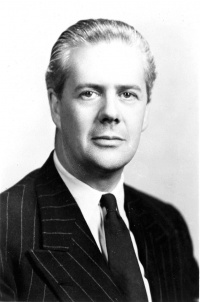John B. S. Coats: Difference between revisions
| Line 51: | Line 51: | ||
== Recorded speeches == | == Recorded speeches == | ||
Several of Mr. Coats' lectures were recorded and are available from [http://www.questbooks.net/author.cfm?authornum=183 Quest Books] and from the [http://magicdb.dupagels.lib.il.us/uhtbin/cgisirsi/?ps= | Several of Mr. Coats' lectures were recorded and are available from [http://www.questbooks.net/author.cfm?authornum=183 Quest Books] and from the [http://magicdb.dupagels.lib.il.us/uhtbin/cgisirsi/?ps=5WLBFEiqHr/TO/286050293/60/1182/X Henry S. Olcott Memorial Library]. | ||
== Notes == | == Notes == | ||
<references/> | <references/> | ||
Revision as of 18:33, 5 July 2012
Early years and family life
John Balfour Symington Coats was born on July 8, 2006 in Ayr, South Ayrshire, Scotland. His father, Ernest Coats, a director of the old Paisley firm of thread manufacturers known internationally as J & P Coats. In 1917, Ernest Coats purchased the ancient Sundrum Castle five miles from Ayr.[1] John was educated at Eton College in England from 1918 to 1924, and studied the French language in France.
He was engaged in the family business for about five years, three of which he spent in Vienna, where he learned German. The business manufactured silk and cotton thread and sewing supplies. It was in Vienna that the young man learned of Theosophy through a chance meeting with a stranger. Within the year, he had joined the Society.[2]
When he returned to London to work at the Stock Exchange, he met his future wife, Elizabeth Ann Horlick,[3] who was always known as Betsan. On October 31, 1933, they were married. They lived at Anton-Dolwells, Milverton, Sometset, England.[4] The couple had five children, one of whom died very young. The surviving children, a girl and three boys, were born in 1937, 1939, 1943, and 1953.[5]
Work with youth groups
Mr. Coats served as President in the Youth Centre in London. Both John and Betsan were active in international activities of the World Federation of Young Theosophists. In 1962, he became head of that organization after Rukmini Devi resigned from the position, and he continued that work until 1974.
Theosophical work
In 1935, the President of the Society, George Arundale, asked Mr. Coats to join the headquarters staff at Adyar. The Coats family lived there for four years. During that period, Mr. Coats frequently joined Dr. Arundale and his wife Rukmini Devi in their travels around the world. Mr. Coats was a congenial man who made friends wherever he went, particularly among the young. His knowledge of French and German helped to be a goodwill ambassador for Theosophy.
During World War II, Mr. Coats served as General Secretary of the English Section. He had joined the British Army, but after a short time was injured in a motorcycle accident and invalided out. Following the war, from 1946-1948, he and Betsan lectured extensively for the Society for three years, in the US, Canada, Mexico and Cuba. Betsan Coats founded an organization in 1952 called "Wings of Friendship," to help rehabilitate displaced people who were still living in camps across Germany, Austria, Italy and Greece.
In 1953, Mr. Coats was elected Secretary of the European Federation of Theosophical Societies, an organization of more than twenty national sections. During that period he lectured in numerous lodges. He assumed the chairmanship of the federation in 1959, and held that position until 1968. His travels during this period took him the North and South America, Australia, Africa, Israel, and several times to India. At the request of Presiden N. Sri Ram, he organized the World Congress in Salzburg, Austria, which took place in 1966.[6] In an autobiographical article, Coats wrote,
In 1968, my children having married and gone away, I sold my house in England and set out on my wanderings on behalf of the Society. I visited South America, the West Indies, Mexico, the U.S.A. and Canada, Honolulu and Fiji, New Zealand, Australia, Indonesia, Malaya, Vietnam, the Philippines and Japan, India, Ceylon, and Pakistan, East, South and West Africa, Israel and nearly every country in Europe.[7]
Liberal Catholic Church
Coats was a bishop in the Liberal Catholic Church.
Presidency of the Society
In 1973, following the death of Nilakanta Sri Ram, Mr. Coats assumed the office of the President of the Theosophical Society. His presidency was distinguished by efforts to reach out to the general public. This emphasis on reaching a wide audience was evident in issues of The Theosophist that he edited. The International Theosophical Youth Centre at Adyar was established during his administration. He died in office on December 26, 1979, which was the opening day of the annual international Convention at Adyar.
Publications
Mr. Coats wrote over 200 articles for Theosophical periodicals. For a list of them, see the Union Index of Theosophical Periodicals.
- The last quarter of the century, Adyar, Chennai, India: Theosophical Publishing House, 1975.
- "What Is a Nucleus of Universal Brotherhood?," The Theosophist (April, 1974), available at the Theosophical Society Website.[6]
Recorded speeches
Several of Mr. Coats' lectures were recorded and are available from Quest Books and from the Henry S. Olcott Memorial Library.
Notes
- ↑ Sundrum Castle Web page at [1]
- ↑ Theosophical Society Website [2].
- ↑ "Biographical Notes of John B. S. Coats," Theosophical Society in Greece Website, from The Theosophist (April, 1980). [3]
- ↑ The International Theosophical Year Book 1938 (Adyar, Madras, India: Theosophical Publishing House, 1938): 173.
- ↑ Peerage.com Web page.[http://thepeerage.com/index.htm[
- ↑ Theosophical Society Website [4].
- ↑ "Biographical Notes of John B. S. Coats," Theosophical Society in Greece Website, from The Theosophist (April, 1980).[5]
